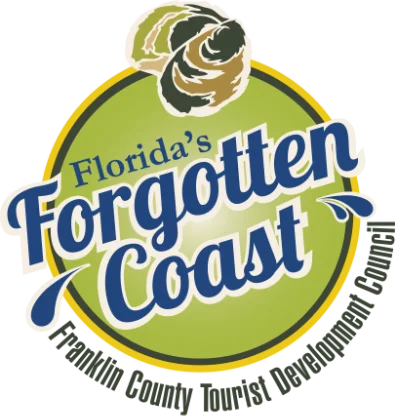You are here: Home > Franklin County Maritime Heritage Museum >
Where The River Meets The Bay
Apalachicola Bay is a highly productive estuarine featuring the perfect balance of environmental conditions necessary for feeding, breeding and nurturing an abundant variety of seafood, including the world-famous Apalachicola Bay oysters.
 The Apalachicola Bay system includes St. George Sound, St. Vincent Sound and East Bay, covering an area of about 208 square miles. The Apalachicola Bay System is shielded from the Gulf of Mexico by a string of barrier islands which include Dog Island to the east, St. Vincent Island to the west, and St. George Island and Cape St. George Island to the south. Saltwater exchange occurs through passes, namely, East Pass, West Pass, Indian Pass, Bob Sikes’ Cut and Dewyers Channel. Most of the freshwater that drains into this large estuary comes from the Apalachicola River.
The Apalachicola Bay system includes St. George Sound, St. Vincent Sound and East Bay, covering an area of about 208 square miles. The Apalachicola Bay System is shielded from the Gulf of Mexico by a string of barrier islands which include Dog Island to the east, St. Vincent Island to the west, and St. George Island and Cape St. George Island to the south. Saltwater exchange occurs through passes, namely, East Pass, West Pass, Indian Pass, Bob Sikes’ Cut and Dewyers Channel. Most of the freshwater that drains into this large estuary comes from the Apalachicola River.
Apalachicola Bay and most of its drainage basin encompass what can be considered one of the least polluted, most undeveloped, resource rich systems left in the United States. The Apalachicola drainage basin includes upland, floodplain, riverine, estuarine, and barrier island environments which are inter-related influenced by each other.
Located in the Northern Gulf Of Mexico, Apalachicola Bay is a major contributor to the exceptionally important nursery area for the Gulf of Mexico. More than 95% of all species harvested commercially and 85% of all species harvested recreationally in the open Gulf have to spend a portion of their life in estuarine waters. Blue crabs, for example, migrate as much as 300 miles to spawn in Apalachicola Bay. Apalachicola Bay is a major forage area for such offshore fish species as gag grouper and gray snapper.
Historically, the bay has provided the perfect habitat for the famous Apalachicola Bay oyster. The Apalachicola Bay oyster industry is based on the highly preferred “American” or “Eastern” oyster, also known by its scientific name crassostrea virginica.
 Second only to oysters, Apalachicola Bay has supported a long history of commercial shrimping. There are three major species of shrimp harvested from the waters in and around Apalachicola Bay: white, brown and pink shrimp. According to State records, Apalachicola Bay shrimpers average more than a million pounds per year, nearly 20% of the state’s shrimp supply. An active blue crab industry also exists in Apalachicola Bay, producing nearly 10 percent of the hard-shell blue crabs landed in Florida. Commercial fish species harvested in the bay include mullet, flounder and pompano.
Second only to oysters, Apalachicola Bay has supported a long history of commercial shrimping. There are three major species of shrimp harvested from the waters in and around Apalachicola Bay: white, brown and pink shrimp. According to State records, Apalachicola Bay shrimpers average more than a million pounds per year, nearly 20% of the state’s shrimp supply. An active blue crab industry also exists in Apalachicola Bay, producing nearly 10 percent of the hard-shell blue crabs landed in Florida. Commercial fish species harvested in the bay include mullet, flounder and pompano.
The Apalachicola estuary also serves as a major forage area for migratory birds. Because of its unique geographic location, the region is also part of the Atlantic and Mississippi flyway – a superhighway for migrating birds. In addition to native bird species, birders also can see migratory birds such as least terns, American oystercatchers, plovers, bald eagles, Peregrine falcons, marsh hawks, sharp-shinned hawks, merlins, kestrels, swallow tail kites, night heron, ospreys, indigo buntings and summer tanagers during annual migration and nesting periods.
Because of its uniqueness, Apalachicola Bay has had numerous protective designations conferred upon it. Apalachicola Bay is one of eighteen Aquatic Preserves, has been designated a National Estuarine Research Reserve by the National Oceanic and Atmospheric Administration (NOAA), and is considered an Outstanding Florida Water. The United Nations Education, Scientific, and Cultural Organization (UNESCO) even designated the Reserve a Biosphere Reserve under the International Man and the Biosphere (MAB) program. All these designations, from state, national, and international agencies, recognize the Apalachicola River and Bay system as a unique and environmentally sensitive resource which deserves protection.

